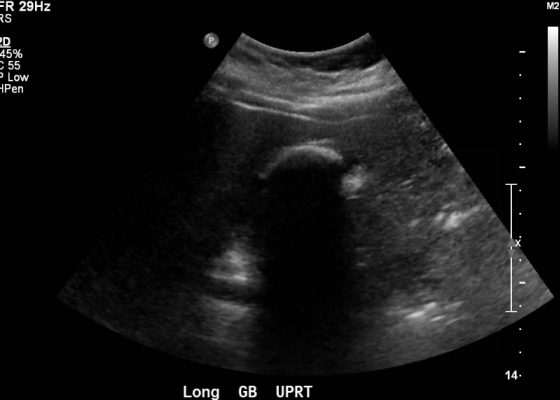Ultrasound
Takotsubo (Stress) Cardiomyopathy
DOI: https://doi.org/10.21980/J8Z309Bedside echocardiography showed the findings consistent with Takotsubo cardiomyopathy. Echocardiographic images are shown in subxiphoid (A) and apical four chamber (B) views. Note the apical ballooning appearance (asterisk) of the left ventricle (LV).
Intraocular Foreign Body: Ultrasound and CT Findings
DOI: https://doi.org/10.21980/J8JS3MPoint of care ultrasound revealed a mobile, radiolucent hyperechoic structure (see red arrow) with reverberation within the posterior chamber (see blue arrow), likely a metallic foreign body. Linear areas of mobile hyperechoic material revealed possible vitreous hemorrhage (see purple circular area). Orbital non-contrast CT confirmed a 3 mm metallic focus within the dependent portion of the left globe, lodged in the posterior sclera, with some vitreous hemorrhage but no evidence of globe rupture. Ophthalmology was consulted and the patient was taken to surgery later that night.
Cholelithiasis: WES Sign
DOI: https://doi.org/10.21980/J8X300Abdominal ultrasound showed the classic presentation of the Wall-Echo-Shadow (WES) sign. The superficial aspect of the gallbladder wall is represented by a hyperechogenic curve. Below this, bile fluid is represented by hypoechogenicity. Underneath the bile fluid is the echo of the dense border created by the collection of gallstones, represented by a hyperechogenic curve. Due to the high density of the gallstones, nothing deeper can be visualized (including other gallstones or the far end of the gallbladder); this is the shadow.
FAST Exam: Normal Suprapubic
Keywords: radiology, trauma, normal, suprapubic, FAST exam, videos, ultrasound, US
FAST Exam: Normal Morrison’s Pouch
Keywords: radiology, normal, renal, Morrison’s pouch, trauma, liver, ultrasound, video, FAST exam
FAST Exam: Normal Morrison’s Pouch
Keywords: radiology, normal, renal, Morrison’s pouch, trauma, liver, ultrasound, FAST exam
Left Ventricular Assist Device (LVAD) Cardiac Ultrasound
Keywords: LVAD, left ventricular assist device, ultrasound, TTE, transthoracic ultrasound Image credit: Drs. Madison Nashu and Megan Guy






